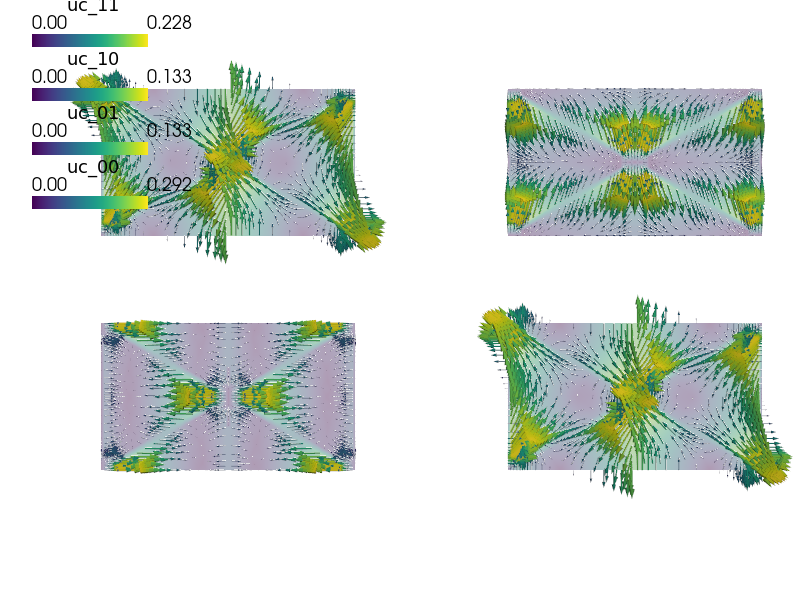homogenization/rs_correctors.py¶
Description
Compute homogenized elastic coefficients for a given microstructure.

#!/usr/bin/env python
"""
Compute homogenized elastic coefficients for a given microstructure.
"""
from argparse import ArgumentParser
import sys
sys.path.append('.')
import numpy as nm
from sfepy import data_dir
import sfepy.discrete.fem.periodic as per
from sfepy.homogenization.utils import define_box_regions
def define_regions(filename):
"""
Define various subdomains for a given mesh file.
"""
regions = {}
dim = 2
regions['Y'] = 'all'
eog = 'cells of group %d'
if filename.find('osteonT1') >= 0:
mat_ids = [11, 39, 6, 8, 27, 28, 9, 2, 4, 14, 12, 17, 45, 28, 15]
regions['Ym'] = ' +c '.join((eog % im) for im in mat_ids)
wx = 0.865
wy = 0.499
regions['Yc'] = 'r.Y -c r.Ym'
# Sides and corners.
regions.update(define_box_regions(2, (wx, wy)))
return dim, regions
def get_pars(ts, coor, mode=None, term=None, **kwargs):
"""
Define material parameters: :math:`D_ijkl` (elasticity), in a given region.
"""
if mode == 'qp':
dim = coor.shape[1]
sym = (dim + 1) * dim // 2
out = {}
# in 1e+10 [Pa]
lam = 1.7
mu = 0.3
o = nm.array([1.] * dim + [0.] * (sym - dim), dtype = nm.float64)
oot = nm.outer(o, o)
out['D'] = lam * oot + mu * nm.diag(o + 1.0)
for key, val in out.items():
out[key] = nm.tile(val, (coor.shape[0], 1, 1))
channels_cells = term.region.domain.regions['Yc'].cells
n_cell = term.region.get_n_cells()
val = out['D'].reshape((n_cell, -1, 3, 3))
val[channels_cells] *= 1e-1
return out
##
# Mesh file.
filename_mesh = data_dir + '/meshes/2d/special/osteonT1_11.mesh'
##
# Define regions (subdomains, boundaries) - $Y$, $Y_i$, ...
# depending on a mesh used.
dim, regions = define_regions(filename_mesh)
functions = {
'get_pars' : (lambda ts, coors, **kwargs:
get_pars(ts, coors, **kwargs),),
'match_x_plane' : (per.match_x_plane,),
'match_y_plane' : (per.match_y_plane,),
'match_z_plane' : (per.match_z_plane,),
'match_x_line' : (per.match_x_line,),
'match_y_line' : (per.match_y_line,),
}
##
# Define fields: 'displacement' in $Y$,
# 'pressure_m' in $Y_m$.
fields = {
'displacement' : ('real', dim, 'Y', 1),
}
##
# Define corrector variables: unknown displaements: uc, test: vc
# displacement-like variables: Pi, Pi1, Pi2
variables = {
'uc' : ('unknown field', 'displacement', 0),
'vc' : ('test field', 'displacement', 'uc'),
'Pi' : ('parameter field', 'displacement', 'uc'),
'Pi1' : ('parameter field', 'displacement', None),
'Pi2' : ('parameter field', 'displacement', None),
}
##
# Periodic boundary conditions.
if dim == 3:
epbcs = {
'periodic_x' : (['Left', 'Right'], {'uc.all' : 'uc.all'},
'match_x_plane'),
'periodic_y' : (['Near', 'Far'], {'uc.all' : 'uc.all'},
'match_y_plane'),
'periodic_z' : (['Top', 'Bottom'], {'uc.all' : 'uc.all'},
'match_z_plane'),
}
else:
epbcs = {
'periodic_x' : (['Left', 'Right'], {'uc.all' : 'uc.all'},
'match_y_line'),
'periodic_y' : (['Bottom', 'Top'], {'uc.all' : 'uc.all'},
'match_x_line'),
}
##
# Dirichlet boundary conditions.
ebcs = {
'fixed_u' : ('Corners', {'uc.all' : 0.0}),
}
##
# Material defining constitutive parameters of the microproblem.
materials = {
'm' : 'get_pars',
}
##
# Numerical quadratures for volume (i3 - order 3) integral terms.
integrals = {
'i3' : 3,
}
##
# Homogenized coefficients to compute.
def set_elastic(variables, ir, ic, mode, pis, corrs_rs):
mode2var = {'row' : 'Pi1', 'col' : 'Pi2'}
val = pis.states[ir, ic]['uc'] + corrs_rs.states[ir, ic]['uc']
variables[mode2var[mode]].set_data(val)
coefs = {
'E' : {
'requires' : ['pis', 'corrs_rs'],
'expression' : 'dw_lin_elastic.i3.Y(m.D, Pi1, Pi2)',
'set_variables' : set_elastic,
},
}
all_periodic = ['periodic_%s' % ii for ii in ['x', 'y', 'z'][:dim] ]
requirements = {
'pis' : {
'variables' : ['uc'],
},
##
# Steady state correctors $\bar{\omega}^{rs}$.
'corrs_rs' : {
'requires' : ['pis'],
'save_variables' : ['uc'],
'ebcs' : ['fixed_u'],
'epbcs' : all_periodic,
'equations' : {'eq' : """dw_lin_elastic.i3.Y(m.D, vc, uc)
= - dw_lin_elastic.i3.Y(m.D, vc, Pi)"""},
'set_variables' : [('Pi', 'pis', 'uc')],
'save_name' : 'corrs_elastic',
'is_linear' : True,
},
}
##
# Solvers.
solvers = {
'ls' : ('ls.auto_direct', {'use_presolve' : True}),
'newton' : ('nls.newton', {
'i_max' : 1,
'eps_a' : 1e-8,
'eps_r' : 1e-2,
})
}
############################################
# Mini-application below, computing the homogenized elastic coefficients.
helps = {
'no_pauses' : 'do not make pauses',
}
def main():
import os
from sfepy.base.base import spause, output
from sfepy.base.conf import ProblemConf, get_standard_keywords
from sfepy.discrete import Problem
import sfepy.homogenization.coefs_base as cb
parser = ArgumentParser(description=__doc__)
parser.add_argument('--version', action='version', version='%(prog)s')
parser.add_argument('-n', '--no-pauses',
action="store_true", dest='no_pauses',
default=False, help=helps['no_pauses'])
options = parser.parse_args()
if options.no_pauses:
def spause(*args):
output(*args)
nm.set_printoptions(precision=3)
spause(r""">>>
First, this file will be read in place of an input
(problem description) file.
Press 'q' to quit the example, press any other key to continue...""")
required, other = get_standard_keywords()
required.remove('equations')
# Use this file as the input file.
conf = ProblemConf.from_file(__file__, required, other)
print(list(conf.to_dict().keys()))
spause(r""">>>
...the read input as a dict (keys only for brevity).
['q'/other key to quit/continue...]""")
spause(r""">>>
Now the input will be used to create a Problem instance.
['q'/other key to quit/continue...]""")
problem = Problem.from_conf(conf, init_equations=False)
# The homogenization mini-apps need the output_dir.
output_dir = ''
problem.output_dir = output_dir
print(problem)
spause(r""">>>
...the Problem instance.
['q'/other key to quit/continue...]""")
spause(r""">>>
The homogenized elastic coefficient $E_{ijkl}$ is expressed
using $\Pi$ operators, computed now. In fact, those operators are permuted
coordinates of the mesh nodes.
['q'/other key to quit/continue...]""")
req = conf.requirements['pis']
mini_app = cb.ShapeDimDim('pis', problem, req)
mini_app.setup_output(save_formats=['vtk'])
pis = mini_app()
print(pis)
spause(r""">>>
...the $\Pi$ operators.
['q'/other key to quit/continue...]""")
spause(r""">>>
Next, $E_{ijkl}$ needs so called steady state correctors $\bar{\omega}^{rs}$,
computed now.
['q'/other key to quit/continue...]""")
req = conf.requirements['corrs_rs']
save_name = req.get('save_name', '')
name = os.path.join(output_dir, save_name)
mini_app = cb.CorrDimDim('steady rs correctors', problem, req)
mini_app.setup_output(save_formats=['vtk'])
corrs_rs = mini_app(data={'pis': pis})
print(corrs_rs)
spause(r""">>>
...the $\bar{\omega}^{rs}$ correctors.
The results are saved in: %s.%s
Try to display them with:
sfepy-view %s.%s
['q'/other key to quit/continue...]""" % (2 * (name, problem.output_format)))
spause(r""">>>
Then the volume of the domain is needed.
['q'/other key to quit/continue...]""")
volume = problem.evaluate('ev_volume.i3.Y(uc)')
print(volume)
spause(r""">>>
...the volume.
['q'/other key to quit/continue...]""")
spause(r""">>>
Finally, $E_{ijkl}$ can be computed.
['q'/other key to quit/continue...]""")
mini_app = cb.CoefSymSym('homogenized elastic tensor',
problem, conf.coefs['E'])
c_e = mini_app(volume, data={'pis': pis, 'corrs_rs' : corrs_rs})
print(r""">>>
The homogenized elastic coefficient $E_{ijkl}$, symmetric storage
with rows, columns in 11, 22, 12 ordering:""")
print(c_e)
if __name__ == '__main__':
main()